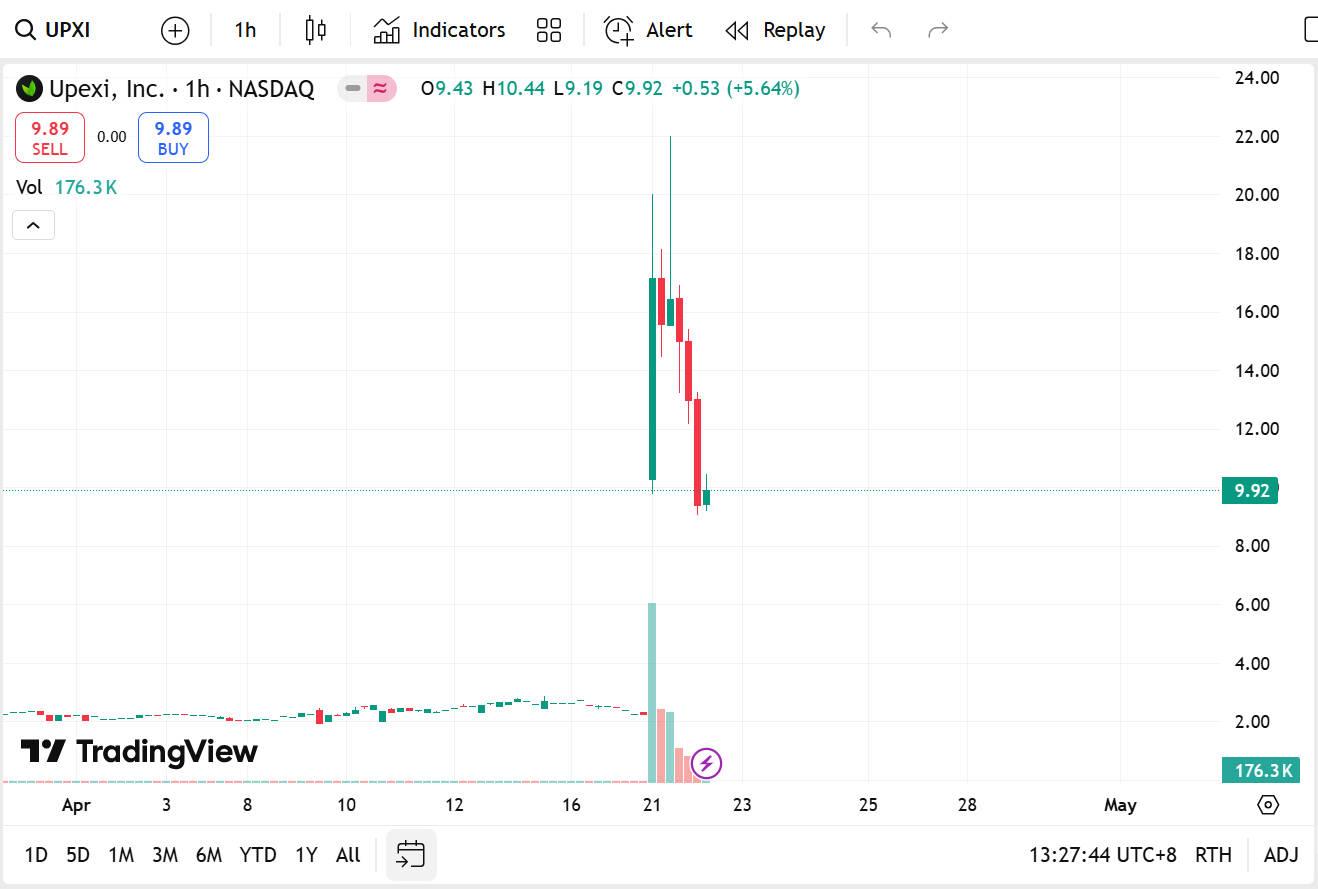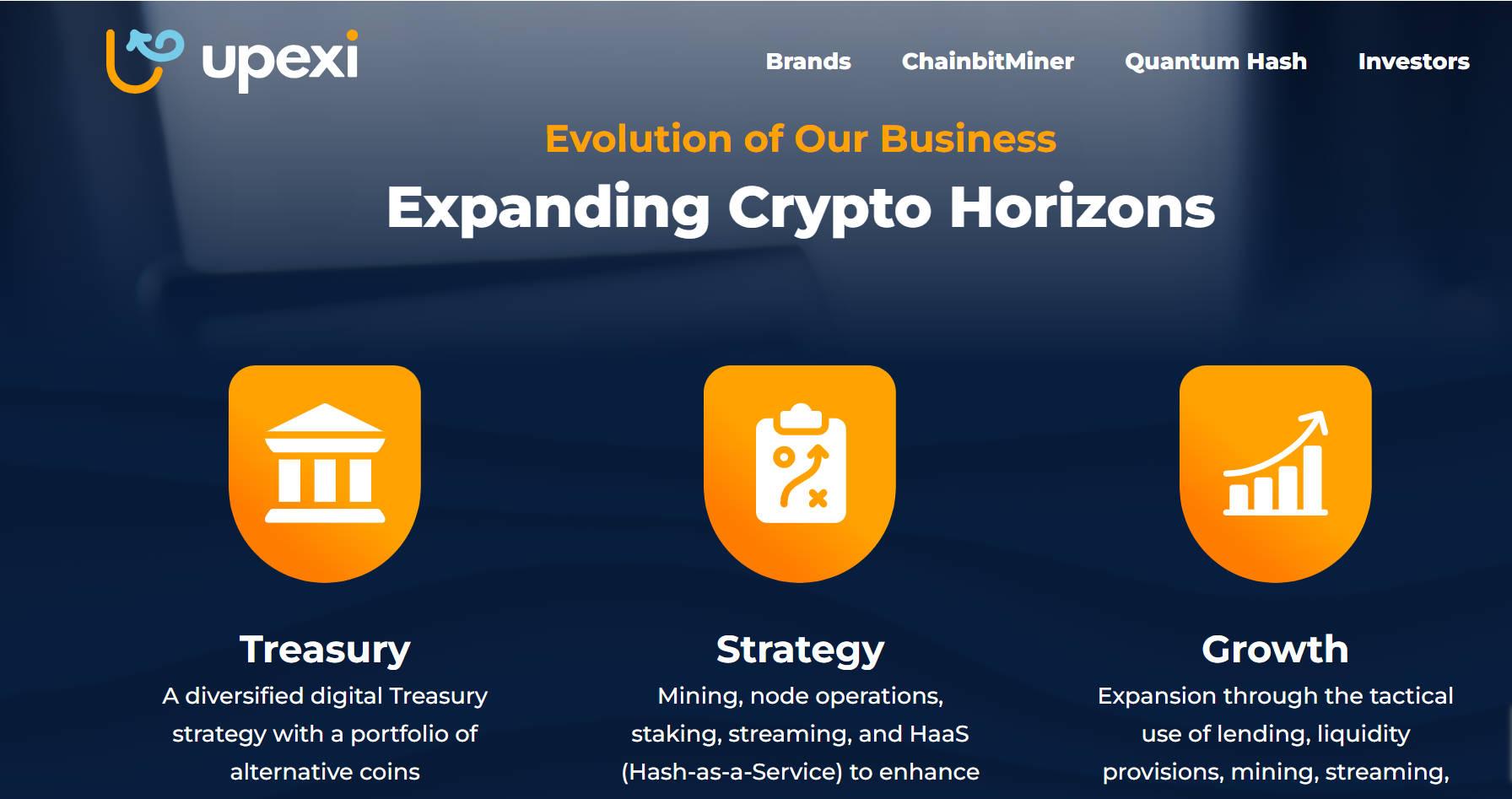U.S.-listed company Upexi has received $100 million in cryptocurrency financing and bets on Solana

Reprinted from panewslab
04/22/2025·28D
Author: Weilin, PANews
With the trend of imitating Strategy's Bitcoin investment and accumulation financial strategies, there are also many imitators of Solana's strategy, including Canadian listed company Sol Strategies Inc., US Nasdaq listed company Janover, etc., and consumer goods listed company Upexi has become the latest traditional company holding similar strategies.
On April 21, well-known cryptocurrency trading and investment company GSR announced that it has made a private equity investment of up to $100 million in Nasdaq-listed consumer goods company Upexi, Inc. (stock code: UPXI), betting on its upcoming Solana financial strategy, which is about to fully transform. Affected by the news, Upexi's stock price soared more than six times during the day.
As early as February this year, Upexi announced its roadmap around cryptocurrencies. In its latest financial report, this consumer product development, manufacturing and distribution company showed that the company's revenue had dropped significantly and its net losses continued. Embracing cryptocurrencies has become a transformation strategy.
GSR bets on Upexi's Solana financial strategy to lead $100 million in
private equity investment
GSR provides direct financial support for Upexi's new on-chain strategy. Upexi announced that it has signed securities purchase agreements with some investors to issue 43,859,649 common shares (or prepaid warrants as a replacement) at a price of US$2.28 per share, with a total raised amount of approximately US$100 million (the fees and other issuance expenses have not been deducted).
Upexi plans to use approximately $5.3 million of the amount to work capital and repay debts, and the remaining funds will be used to build the company's Solana-based fiscal system and the accumulation of Solana assets.
In addition to GSR's lead investment, there are also a number of institutions and individuals in the currency circle participating in this round of financing, including Big Brain, Anagram, Delphi Ventures, White Star Capital, Maelstrom (Arthur Hayes Family Office), Hivemind, Borderless, Morgan Creek, Elune Capital, Delta Blockchain Fund, etc. In addition, several well-known angel investors participated, including Austin Federa, Frank Chaparro, Joey Krug, Bartosz Lipinski, Larry Wu and Jordan Prince, etc., as well as Upexi CEO Allan Marshall.
Lily Liu, president of the Solana Foundation, also said the deal marks another step in connecting traditional financial institutions with decentralized infrastructure.
The market after the news was announced showed that the share price of Nasnak listed company Upexi rose 639.20% to $16.78. As of the close of US stocks on April 21, Upexi's stock price fell back to $9.89.

While this news attracted widespread attention from the crypto market, some crypto industry insiders also gave their positive views. Arif Kazi, head of business development at Sonic SVM, said on X platform: “The public market’s perception of on-chain benefits has changed. Upexi is not hedging risks – they regard SOL staking as infrastructure. Native staking is becoming an institutional-level financial instrument.”
He said this may be the largest Solana native fiscal allocation for US listed companies. Pricing is higher than the market price, and there are no terms such as tokens, lock-in or convertible bonds. Solana's architecture makes this possible: parallel execution, subsecond final confirmation time, and a stable validator network layer through Sealevel technology. This is the infrastructure built for institutions. When the financial policy strategy is combined with the DeFi primitive, this is not only a fit, but also an acceleration. Solana now provides capital allocators with a set of operating manuals.
From Gummies to Cryptocurrency: Upexi's on-chain transformation

Headquartered in Tampa, Florida, Upexi used to focus on the research and development, manufacturing and distribution of consumer products. Its brands include Cure Mushrooms, a medicinal mushroom product, LuckyTail, and a Prax series mainly based on energy gummy. Although this traditional consumer goods model once gave it a foothold in the market, it has never received much attention in the capital market. As of April 18 (last Friday local time), its market value was only US$3 million.
Upexi, Inc.'s latest financial report shows the significant financial challenges it faces. In the six months ended December 31, 2024, the company's revenue declined and its net losses continued. Revenue during the reporting period was US$8.36 million, a sharp drop from US$15.74 million in the same period last year. The company's net loss was $2.93 million, slightly better than the $3.79 million loss in the same period last year.
Or under such financial pressure, cryptocurrencies are seen as new opportunities by Upexi. In fact, Upexi's encryption strategy has gradually begun a few months ago. On March 3, Upexi announced that its subsidiary Quantum Hash had signed a letter of intent (LOI) to acquire a 2-megawatt crypto mine. The mine currently has less than half of its usage rate. Quantum Hash plans to upgrade existing equipment after the transaction is completed and introduce the latest and fastest mining machines to maximize computing power and monthly Bitcoin production.
On February 6, Upexi announced that it is actively seeking further investment opportunities in the near future, expanding its business portfolio through direct investment in cryptocurrencies, mining businesses and mergers and acquisitions in the financial technology field. The company updates its current business operations to shareholders and discloses its long-term encryption and mining strategic plan.
Upexi CEO Allan Marshall, 55, joined the company as CEO in May 2019. He has previously retired and was a serial entrepreneur who has focused on the technology industry in recent years. He began his career in the transportation and logistics industry. He said, "The company is in a series of rapid development opportunities and will continue to promote the implementation and advancement of various strategies in the next few weeks and months."
According to the official website, after the transformation, Upexi has the following development strategies: first, it is a financial strategy: a diversified digital financial strategy covering a variety of altcoin asset portfolios; second, it is a strategic direction: improve financial returns through mining, node operations, staking, streaming services, and HaaS (computing power as a service). In terms of growth paths, business expansion will be achieved through strategic use of lending, liquidity provision, mining, streaming services and capital markets.
Upexi has released its strategic roadmap for 2025, including:
Bitcoin and altcoin mining: Have at least 1-3 megawatts (MW) of low-priced mining operation facilities within 90 days; complete due diligence on mining projects currently operating at 2-5 megawatts; target to have 10-20 megawatt mining facilities; expand mining operations to other altcoins, such as Ethereum and AI-powered blockchain assets.
Crypto asset portfolio construction: build a diversified digital asset portfolio, including Bitcoin, Ethereum, Solana, Render, and Chainlink; seize favorable opportunities to make strategic purchases when market fluctuations; hold other assets with the growth potential of blockchain infrastructure and the value of AI convergence.
Financial focus direction based on blockchain. Explore opportunities in the following fields: staking, decentralized lending, blockchain projects with income generation models
Long-term focus includes: Web3, Decentralized Finance (DeFi), and AI-driven blockchain growth
Sol strategy aims to achieve organic growth, and market volatility may
bring about "book loss dilemma"
In this GSR's investment in Upexi, no more specific contents of Solana's financial strategy were disclosed. However, the practice of SOL Strategies, which was the first to propose Sol strategy, may bring samples to Upexi. CEO Leah Wald recently said that comparing SOL Strategies to Solana's Microstrategy is actually an incomplete analogy. Leah Wald said, “In my opinion, the limitation of this model is that it simply plays the "Net Asset Value (NAV) game, that is, to increase the value of the company by accumulating assets, but that is not enough. Our strategy is to achieve growth in a slower but steady way. In the early stages, we rely mainly on external acquisitions (inorganic growth) to expand our business, such as acquisitions of validators and related assets. Over time, we will gradually turn to natural growth (organic growth) that relies on our capabilities.
He said SOL Strategies’ ultimate goal is to become Solana’s infrastructure company. In this process, we are really accumulating as much SOL as possible and staking it to our validator node. But this is only part of the overall strategy, and we are not just “buying SOL” but playing a practical role in Solana’s infrastructure ecosystem.
It is worth noting that as more and more listed companies are actively promoting crypto asset reserve plans, this strategy is becoming a new trend in corporate asset allocation. However, with the superposition of multiple factors such as fluctuations in the global economic environment, panic caused by policy uncertainty, and concentrated departure of profitable markets, the crypto market has experienced drastic fluctuations, and many listed companies will also fall into the dilemma of floating losses on the books.
In general, Upexi, which is struggling to make breakthroughs in the traditional consumer goods market, is embarking on a radical transformation from "gummies to cryptocurrencies". The $100 million financing not only provides a strong support for its Solana financial policy strategy, but also opens up a broader imagination space for its mining, crypto asset portfolio and blockchain financial layout. With the support of mainstream institutions such as GSR, Upexi may provide a set of reference templates for more listed companies to enter on-chain finance.
But this transformation journey is still full of uncertainty. From the violent fluctuations in stock prices, to the continuous losses of the main consumer goods business, to the high risks and policy challenges of the crypto market itself, whether Upexi can embark on a truly sustainable growth path from the "crypto experiment" in the future still needs time to verify.

